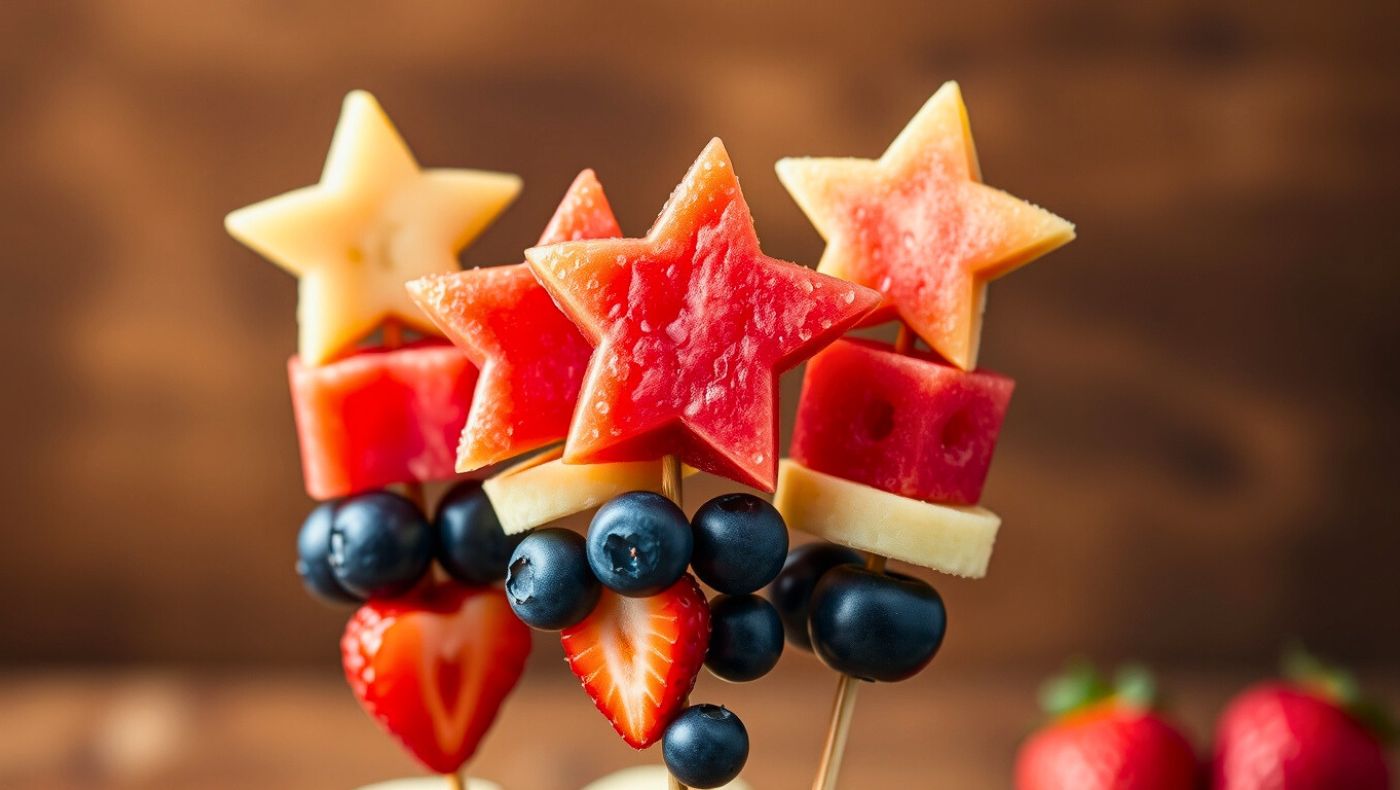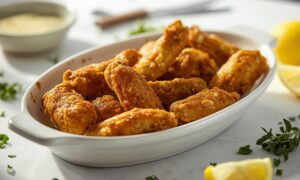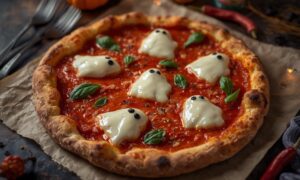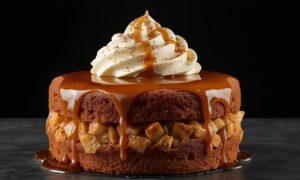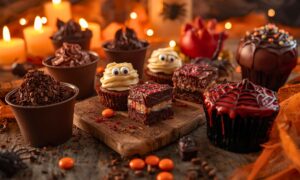Ever tried eating a rainbow on a stick? That’s what Fruit Sparklers with Melon Magic taste like, juicy, colorful, and totally irresistible. I made these for a summer picnic once… they vanished before the grill even fired up!
Think crisp watermelon, sweet berries, and fresh melon stars, all stacked and sparkling. They’re fun, healthy, and party-perfect. No mess, no fuss, just pure fruity joy.
In this post, you’ll learn how to make Fruit Sparklers with Melon Magic using simple ingredients and a few clever tips. No fancy gear needed.
Great for July 4th, birthday parties, or just sunny afternoons. Even picky eaters love them. These fruity bursts are easy to prep, kid-friendly, and endlessly fun.
Want to take it further? Try pairing fresh fruit with sparkling water or champagne to make fizzy frozen treats that really pop. The carbonation adds lift and texture for that magical sparkle effect.
Whether you serve them at a backyard BBQ or a wedding table, Fruit Sparklers with Melon Magic bring the wow. Light, bright, and a little bit fancy, every bite is a celebration.
Ingredients & Substitutions for Fruit Sparklers With Melon Magic
Fresh Fruit Puree (2 cups) Start with ripe, seasonal fruit. Strawberries, peaches, and mangoes work beautifully. They bring natural sweetness and vibrant colors. Berries like blueberries or raspberries add tartness. This balances the sweetness perfectly. Avoid overripe fruit it creates muddy flavors and poor textures.
For stone fruits, blanch and peel first. The skins create bitter notes. These clash with the delicate carbonation. Citrus fruits need special handling. Use only the juice and avoid the pith completely.
Sparkling Water or Champagne (1 cup) Quality matters here. Cheap sparkling water loses carbonation quickly and tastes flat. San Pellegrino or Perrier maintain their fizz longer during freezing. For adult versions, use dry champagne or prosecco never sweet varieties. These throw off the sugar balance.
Club soda works in a pinch, but its saltier undertones muddy delicate fruit flavors. Avoid tonic water entirely. The quinine creates an unpleasant medicinal aftertaste when frozen.
Honey or Simple Syrup (2-4 tablespoons) Raw honey adds complexity, but it can overpower subtle fruits like white peaches. Simple syrup dissolves more evenly. It won’t crystallize during freezing. Agave nectar works for vegan preparations, though it’s slightly more intense than honey.
Avoid artificial sweeteners they create unpleasant chemical aftertastes. Freezing amplifies these tastes. Stevia can work, but use it sparingly. A little goes too far quickly.
Lemon Juice (1 tablespoon) This isn’t optional. Acid brightens flavors and prevents oxidation. This stops fruit purees from turning brown. Fresh lemon juice contains natural enzymes. Bottled versions lack these enzymes. These enzymes help break down fruit fibers, creating smoother textures.
Lime juice works for tropical fruits like mango or pineapple. White wine vinegar works in emergencies, but use half the amount it’s more acidic than citrus.
Edible Glitter or Fruit Pieces (optional) Real edible glitter costs more but creates professional results. Avoid craft glitter it’s not food safe despite what some online tutorials suggest. Luster dust mixed with a tiny amount of vodka creates paintable shimmer. This works for more artistic presentations.
Small fruit pieces add texture, but they create ice crystals. These affect the smooth freeze. Dice them tiny no larger than 1/4 inch. Pat them completely dry before adding.
Step-by-Step Instructions
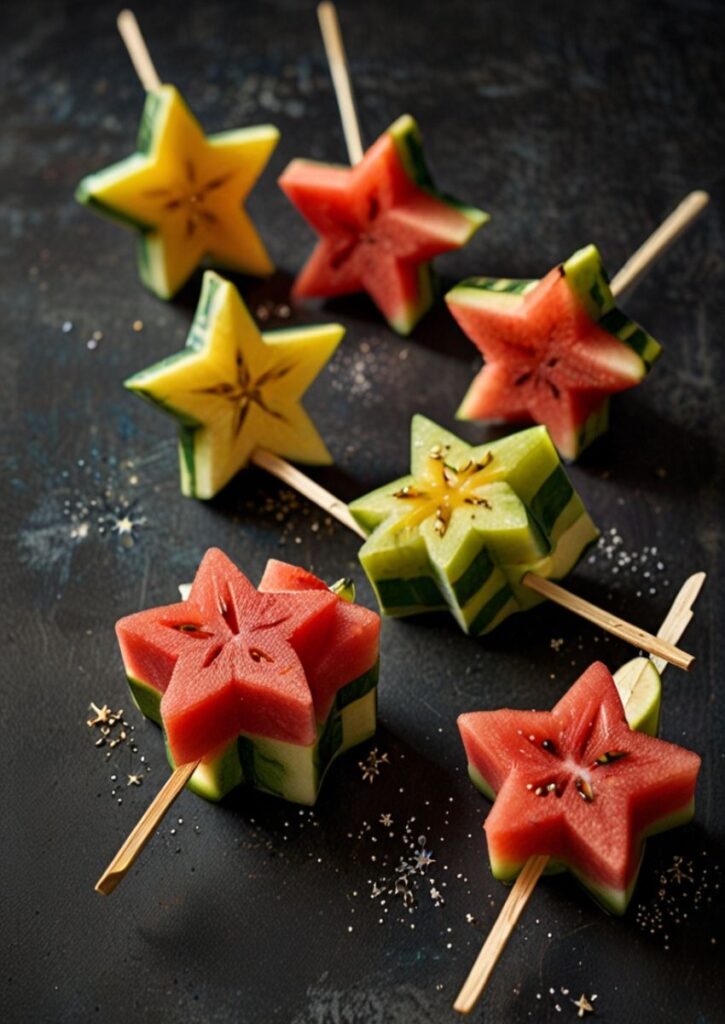
Prepare Your Fruit Base Wash and prepare your chosen fruit. Remove any stems, pits, or damaged areas. For berries, a gentle rinse works over-washing removes natural fruit waxes. These waxes contribute to texture. Pat everything completely dry. Excess water dilutes flavors and affects freezing patterns.
Puree the fruit in a food processor until completely smooth. This takes longer than most people think usually 2-3 minutes of continuous processing. Scrape down the sides frequently. This ensures even processing. The mixture should be completely smooth with no visible chunks.
Strain the puree through a fine-mesh sieve. This removes seeds and any remaining pulp. Press the solids firmly with the back of a spoon. This extracts maximum flavor. This step separates professional results from amateur attempts smooth texture is crucial for proper freezing.
Balance Your Flavors Taste your puree and adjust sweetness gradually. Frozen desserts taste less sweet than their room-temperature counterparts, so err slightly on the sweeter side. Add honey or simple syrup one tablespoon at a time, mixing thoroughly between additions.
Add lemon juice and taste again. The acid should brighten the fruit flavors without making them tart. If you’ve gone too far, add a bit more sweetener to balance. This back-and-forth is normal great fruit sparklers require patience with flavor balancing.
Remember that carbonation adds its own subtle flavor. If you’re using champagne, account for its dry, slightly yeasty notes when adjusting sweetness.
Incorporate Carbonation Carefully This is where most attempts fail. Pour the sparkling water or champagne very slowly into the fruit puree, stirring gently with a spoon never a whisk. Vigorous mixing releases CO2 and defeats the purpose.
The mixture will foam up initially. Let it settle for 30 seconds, then stir once more very gently. You want to combine the ingredients without losing carbonation. Work quickly from this point CO2 dissipates rapidly at room temperature.
Add any edible glitter or small fruit pieces now, folding them in with the gentlest possible motions. Each stir releases precious carbonation.
Freeze with Precision Pour the mixture into popsicle molds immediately after combining. Fill them about 3/4 full the liquid expands as it freezes, and carbonation can cause overflow if you’re not careful.
Insert sticks at a slight angle, not straight down. Angled sticks are easier to grip when frozen and less likely to pull out when removing the finished sparklers. If using wooden sticks, soak them in water for 30 minutes first to prevent splintering.
Place molds in the freezer on a level surface. Don’t disturb them for at least 2 hours. Opening the freezer repeatedly releases cold air and causes uneven freezing patterns that affect texture.
Monitor the Freeze Check after 2 hours the sparklers should be firm but not rock-hard. If they’re still liquid in the center, give them another hour. Over-freezing makes them difficult to remove from molds and can cause cracking.
For professional presentation, remove them when they’re just set but still slightly soft in the very center. They’ll finish firming up and be perfect when served.
Cooking Techniques & Science
The science behind Fruit Sparklers involves understanding how carbonation behaves during phase changes. As water freezes, dissolved CO2 gets trapped in ice crystals. This creates the signature texture that makes these treats special. However, rapid temperature changes cause CO2 to escape too quickly. This results in flat, dense popsicles.
Professional kitchens use blast chillers to freeze Fruit Sparklers rapidly while preserving carbonation. Home cooks can simulate this by placing molds in the coldest part of their freezer usually the back wall. Avoid temperature fluctuations.
The key lies in sugar content. Too little sugar, and the mixture freezes too hard. This traps CO2 ineffectively. Too much, and it won’t freeze properly at standard freezer temperatures. The sweet spot is around 15-18% sugar content. Most fruit purees naturally approach this with minimal added sweeteners.
Acid plays a crucial role beyond flavor enhancement. Citric acid helps stabilize the carbonation by lowering the pH, which reduces CO2 solubility and helps it stay suspended in the mixture longer. This is why lemon juice isn’t optional it’s chemically necessary for proper texture development.
Temperature control during mixing is critical. Cold ingredients hold carbonation better than room-temperature ones. Professional kitchens often chill their fruit purees before adding sparkling components. The ideal mixing temperature is around 35-40°F, just above freezing but well below room temperature.
Serving & Pairing Suggestions
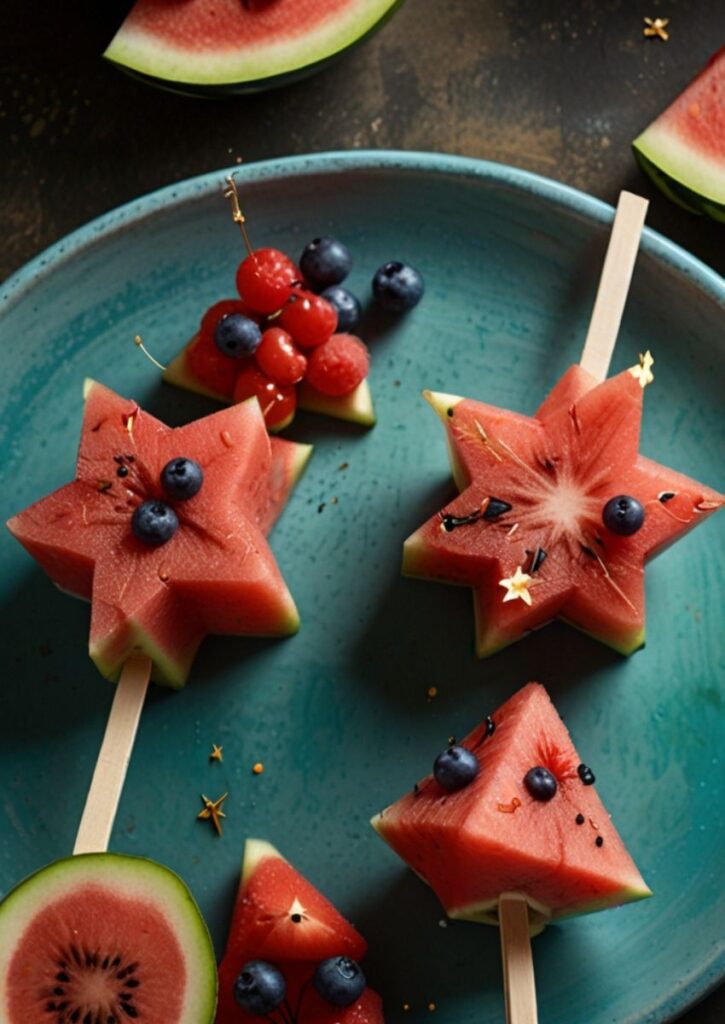
Present fruit sparklers on chilled plates or in champagne flutes for upscale events. The contrast between the frozen treat and elegant glassware creates visual drama that impresses guests consistently. Garnish plates with fresh mint leaves or a light dusting of powdered sugar for professional presentation.
For cocktail parties, serve sparklers alongside prosecco or champagne the flavor pairing is natural and sophisticated. The effervescence in both the drink and dessert creates a cohesive flavor experience that guests remember long after the event ends.
Children’s presentations benefit from colorful accessories. Serve sparklers in bright bowls or on plates decorated with additional fruit pieces. The visual excitement enhances the eating experience and makes healthy treats more appealing than processed alternatives.
Pair strawberry sparklers with shortbread cookies or vanilla wafers. The crisp textures contrast beautifully with the smooth, cold treat. Peach sparklers work wonderfully with almond-based desserts the stone fruit and nut combination is classic for good reason.
For elegant dinner parties, serve sparklers between courses as palate cleansers. Their light, refreshing nature prepares the palate for the next course without overwhelming diners. This technique is common in high-end restaurants but rarely used in home entertaining.
Wine pairings might seem unusual for frozen treats, but they work beautifully. Light, crisp white wines like Sauvignon Blanc complement citrus-based sparklers. Moscato pairs naturally with sweeter fruit varieties like mango or pineapple.
Professional tip: serve sparklers slightly softened rather than rock-hard from the freezer. Remove them 2-3 minutes before serving to achieve the perfect texture. They should yield slightly to gentle pressure but maintain their shape completely.
Advanced Variations of Fruit Sparklers With Melon Magic
Layered Sparklers Create stunning visual impact by layering different colored fruit purees. Pour the first layer and freeze for 30 minutes before adding the second. This technique requires precise timing too long between layers creates separation, too short results in muddy colors.
Use contrasting flavors that complement each other. Strawberry and kiwi create beautiful color contrast, while mango and raspberry offer both visual and flavor complexity. Each layer needs identical sugar content to freeze at the same rate.
Alcoholic Versions Adult sparklers incorporate spirits for sophisticated flavor profiles. Vodka works with almost any fruit combination and doesn’t interfere with carbonation. Rum pairs beautifully with tropical fruits, while gin adds herbal complexity to berry-based sparklers.
Limit alcohol to 1-2 tablespoons per batch too much prevents proper freezing. The alcohol content should enhance, not overpower, the fruit flavors. Professional bartenders often use fruit liqueurs instead of hard spirits for more integrated flavors.
Herb-Infused Sparklers Fresh herbs elevate fruit sparklers from simple treats to sophisticated desserts. Basil pairs surprisingly well with strawberries, while mint enhances almost any fruit combination. Thyme works beautifully with stone fruits like peaches or apricots.
Infuse herbs by steeping them in simple syrup before adding to the fruit puree. This extracts maximum flavor without adding unwanted plant matter to the final product. Strain thoroughly before incorporating into the sparkler mixture.
Probiotic Sparklers Health-conscious consumers appreciate sparklers made with kombucha instead of sparkling water. The fermented tea adds complexity and provides beneficial probiotics that survive the freezing process partially. Use unflavored kombucha to avoid competing flavors.
Balance is crucial with kombucha sparklers the fermented tea can be quite tart. Increase sweetener slightly to compensate, and choose naturally sweet fruits like mango or pineapple for the best results.
Troubleshooting Common Problems in Fruit Sparklers With Melon Magic
Flat Sparklers If your sparklers lack carbonation, the problem usually lies in mixing technique or timing. Over-mixing releases CO2 before freezing can trap it. Warm ingredients also cause carbonation loss always chill fruit purees before adding sparkling components.
Storage issues can also cause flat sparklers. Freezer temperature fluctuations allow CO2 to escape gradually. Maintain consistent freezer temperatures and consume sparklers within one week for optimal carbonation retention.
Icy Texture Large ice crystals create unpleasant, grainy textures that ruin the eating experience. This usually results from slow freezing or insufficient sugar content. Increase your freezer’s coldness setting and ensure fruit purees contain adequate natural or added sugars.
Water content affects texture significantly. Watery fruits like watermelon need thickening agents like a small amount of cornstarch or gelatin to achieve proper consistency. Add these agents to the fruit puree before incorporating carbonation.
Difficulty Removing from Molds Stuck sparklers frustrate even experienced cooks. Run warm water over the outside of molds for 10-15 seconds no longer, or you’ll melt the surface. Silicone molds release more easily than plastic ones and are worth the investment for frequent sparkler making.
Slightly under-freeze sparklers if you’re serving them immediately. They’ll be easier to unmold and will finish firming up within minutes of exposure to room temperature air.
Color Bleeding Layered sparklers sometimes develop muddy colors when different layers bleed together. This happens when layers aren’t sufficiently frozen before adding the next one, or when the color contrast isn’t strong enough to maintain definition.
Use highly contrasting colors and ensure each layer is firm before proceeding. Natural food coloring can enhance contrast if needed, but use it sparingly artificial colors taste unpleasant when frozen.
Professional Kitchen Applications
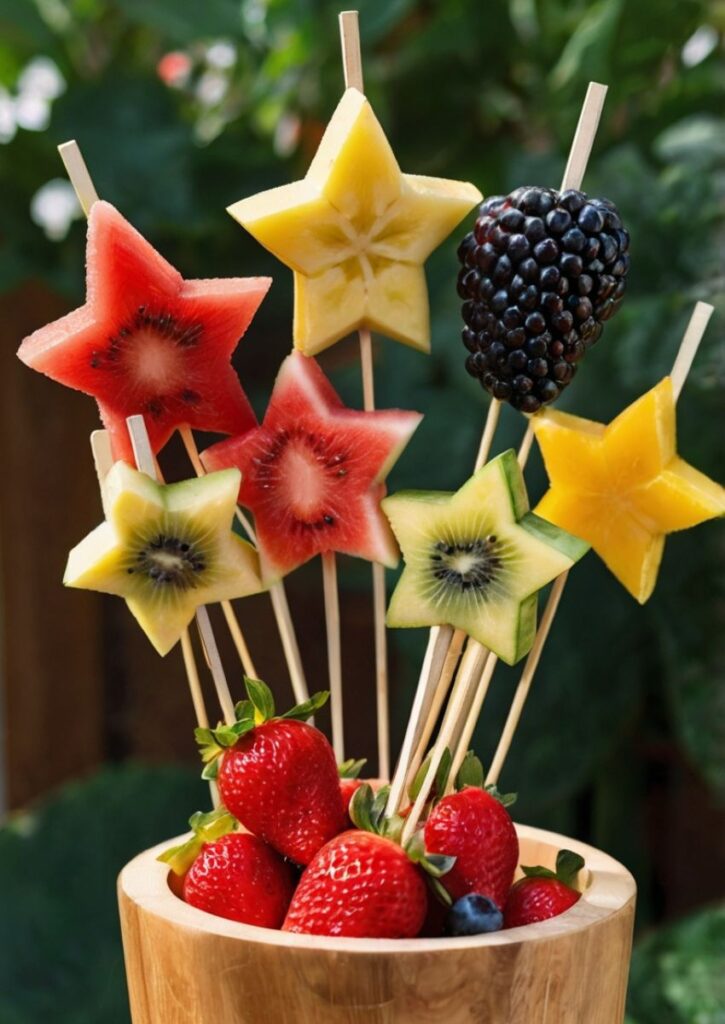
High-end restaurants increasingly feature fruit sparklers on dessert menus as sophisticated palate cleansers or light dessert options. Their visual appeal photographs well for social media marketing, making them valuable for restaurant promotion beyond their taste appeal.
Catering companies find sparklers profitable because they’re make-ahead items that actually improve with time up to a point. The flavors meld and develop complexity during freezing, unlike many desserts that deteriorate quickly after preparation.
Wedding planners love sparklers for outdoor summer receptions. They’re elegant enough for formal events but practical enough to serve without melting disasters. Custom flavors can match wedding colors or reflect personal preferences of the couple.
Hotels with poolside service find sparklers perfect for daytime dessert offerings. They’re refreshing without being too heavy, and the carbonation provides novelty that keeps guests ordering them repeatedly throughout their stay.
Food trucks specializing in artisanal frozen treats often build entire menus around sparkler variations. The premium ingredients justify higher price points than traditional popsicles, while the unique texture creates customer loyalty that drives repeat business.
Corporate catering benefits from sparklers’ dietary flexibility. They’re naturally gluten-free, can be made vegan easily, and accommodate most dietary restrictions without compromising flavor or presentation quality.
Seasonal Adaptations
Spring Sparklers Early spring fruits like strawberries and rhubarb create sparklers that celebrate the season’s first fresh flavors. Rhubarb requires extra sweetener but provides beautiful pink color and tart complexity that adults especially appreciate.
Floral elements work beautifully in spring sparklers. Rose water or elderflower cordial adds sophistication without overwhelming fruit flavors. Use these aromatics sparingly their intensity concentrates during freezing.
Summer Peak Season Summer’s abundance offers endless sparkler possibilities. Stone fruits reach peak ripeness, providing natural sweetness that requires minimal added sugar. Berries are at their flavor peak, creating sparklers with intense, concentrated tastes.
Layer different summer fruits for rainbow effects that celebrate the season’s bounty. Peach, strawberry, and blueberry layers create patriotic color schemes perfect for summer holidays.
Fall Transitions Apple and pear sparklers bridge summer and fall beautifully. Cook these fruits briefly with cinnamon and nutmeg before pureeing to develop deeper flavors that complement the carbonation naturally.
Cranberries need significant sweetening but create stunning ruby-colored sparklers perfect for autumn entertaining. Blend them with sweeter fruits like apple or pear for balanced flavor profiles.
Winter Citrus Winter citrus varieties create sparklers when other fresh fruits are scarce or expensive. Blood oranges provide dramatic color and complex flavor that impresses dinner party guests consistently.
Pomegranate juice creates jewel-toned sparklers that feel luxurious and festive. The antioxidants provide health benefits that health-conscious consumers appreciate, especially during cold season.
Storage and Shelf Life of Fruit Sparklers With Melon Magic
Properly stored fruit sparklers maintain quality for up to two weeks, though carbonation levels diminish gradually over time. Wrap individual sparklers in plastic wrap or store in airtight containers to prevent freezer burn and flavor absorption from other freezer contents.
Commercial establishments often vacuum-seal sparklers for longer storage and professional presentation. Home cooks can simulate this by pressing out air bubbles before sealing storage bags tightly.
Label sparklers with preparation dates and flavor descriptions frozen treats become difficult to identify after several days in storage. Include any dietary restriction information for food service applications.
Temperature stability during storage is crucial. Avoid storing sparklers in freezer doors where temperature fluctuations are common. The main freezer compartment provides more consistent temperatures that preserve texture and carbonation better.
For maximum quality retention, consume homemade sparklers within one week. Commercial operations with blast chillers can extend this timeframe, but home freezers can’t maintain the ideal storage conditions indefinitely.
Fruit Sparklers: The Final Word
Fruit Sparklers represent the perfect intersection of technical skill and creative expression. This defines modern culinary arts. These aren’t just frozen treats they’re sophisticated desserts. They require understanding of food science, flavor balance, and presentation techniques. These separate professional results from amateur attempts.
Mastering carbonation incorporation takes practice, but the results justify the effort invested. Each successful batch builds confidence and skill. This transfers to other culinary applications. The techniques you develop making Fruit Sparklers improve your overall understanding. You learn how temperature, time, and technique interact in professional kitchens.
Fruit Sparklers offer incredible versatility in any culinary repertoire. From casual family gatherings to upscale catering events, these treats adapt to any occasion. They maintain their sophisticated appeal and refreshing nature throughout.
Remember that great Fruit Sparklers start with great ingredients treated with respect and precision. Quality fruit, proper carbonation handling, and careful temperature control create results. These impress consistently and build reputation for culinary excellence.
Don’t be discouraged by early attempts that don’t meet your expectations. Even professional pastry chefs needed practice to perfect their sparkler techniques. Each batch teaches valuable lessons about ingredient behavior and technique refinement that improves future results.
The joy on faces when people taste perfectly executed fruit sparklers makes every effort worthwhile. That moment of surprise and delight when the carbonation hits their palate that’s what makes culinary arts rewarding beyond just technical achievement.
Frequently Asked Questions About Fruit Sparklers With Melon Magic
Q: How long do fruit sparklers maintain their carbonation?
A: Properly made sparklers retain noticeable carbonation for 3-4 days when stored correctly. After that, they’re still delicious but lose the signature “pop” that makes them special. For professional service, prepare sparklers no more than 2 days in advance for optimal quality.
Q: Can I use frozen fruit instead of fresh?
A: Yes, but thaw completely and drain excess liquid first. Frozen fruit often contains more water than fresh, which can dilute flavors and affect freezing patterns. Pat thawed fruit dry before pureeing for best results.
Q: What’s the ideal freezer temperature for sparklers?
A: Standard home freezers at 0°F (-18°C) work fine, but slightly colder temperatures around -5°F (-21°C) preserve carbonation better. Avoid temperatures below -10°F (-23°C), which can cause texture problems and make sparklers too hard to eat comfortably.
Q: Why do my sparklers crack when freezing?
A: Cracking usually results from rapid temperature changes or over-freezing. Ensure your freezer temperature is stable and avoid opening it frequently during the initial freeze. If cracking persists, reduce the liquid volume in each mold slightly.
Q: Can diabetics enjoy fruit sparklers safely?
A: Natural fruit sugars make sparklers suitable for many diabetic diets, but individual tolerance varies. Substitute artificial sweeteners if needed, though they may affect texture slightly. Consult healthcare providers about incorporating any new foods into diabetic meal plans.

Swiftly Captions by Tina Smith — Quick, flavorful food recipes made simple, bringing fresh inspiration to your kitchen every day
